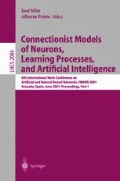Abstract
Neural networks are often selected as the tool for solving regression problem because of their capability to approximate any continuous function with arbitrary accuracy. A major drawback of neural networks is their complex mapping which is not easily understood by a user. This paper describes a method that generates decision rules from Trained neural networks for regression problems. The networks have a Single layer of hidden units with hyperbolic tangent activation function and a single output unit with linear activation function. The crucial step in this method is the approximation of the hidden unit activation function by a 3-piece linear function. This linear function is obtained by minimizing the sum of squared deviations between the hidden unit activation values are generated. The conditions of the rules divide the input space of the data into subspaces, while the consequence of each rule is a linear regression function. Our experimental results indicate that the method generates more accurate rules than those from similar methods.
Access this chapter
Tax calculation will be finalised at checkout
Purchases are for personal use only
Preview
Unable to display preview. Download preview PDF.
References
Blake, C., Keogh, E. and Merz, C. J. (1998) UCI Repository of Machine Learning Databases, Dept. of Information and Computer Science, University of California, Irvine. http://www.ics.uci.edu/_mlearn/MLRepository.html.
Cybenko, G. (1989) Approximation by superpositions of a sigmoidal function. Mathematics of Control, Signals, and Systems, 2, 303–314.
Dennis Jr. J. E. and Schnabel, R. E. (1983) Numerical methods for unconstrained optimization and nonlinear equations. Englewood Cliffs, New Jersey: Prentice Halls.
Setiono, R. and Hui, L. C. K. (1995) Use of quasi-Newton method in a feedforward neural network construction algorithm, IEEE Trans. on Neural Networks, 6(1), 273–277.
Hornik, K. (1991) Approximation capabilities of multilayer feedforward networks. Neural Networks, 4, 251–257.
John, G., Kohavi, R. and Peger, K. (1994) Irrelevant features and the subset selection problem. In Proc. of the 11th ICML Learning, Morgan Kaufman, San Mateo, 121–129.
Khattree, W. and Naik, D. N. (1999) Applied multivariate statistics with SAS software. SAS Institute, Carey, N.C.
Ludl, M-C. and Widmer, G. (2000) Relative unsupervised discretization for regression problems. In Proc. of the 11th ECML, ECML 2000, Lecture Notes in AI 1810, Springer, R. A. Mantaras and E. Plaza (Eds), 246–253, Barcelona.
Quinlan, R. (1993) C4.5: Programs for machine learning. Morgan Kaufmann, San Meteo, CA.
Setiono, R. and Leow, W. K. (2000) Pruned neural networks for regression. In Proc. of the 6th Pacific Rim Conference on Artificial Intelligence, PRICAI 2000, Lecture Notes in AI 1886, Springer, R. Mizoguchi and J. Slaney (Eds), 500–509, Melbourne.
Torgo, L. (1997) Functional models for regression tree leaves. In Proc. of the ICML, ICML-97, Fisher, D. (Ed), Morgan Kaufman, San Mateo, CA.
Torgo, L. and Gama, J. (1997) Search-based class discretization. In Proc. of the 9th European Conference on Machine Learning, ECML-97, Lecture Notes in AI 1224, Springer, M. van Someren and G. Widmer (Eds), 266–273, Prague.
Author information
Authors and Affiliations
Editor information
Editors and Affiliations
Rights and permissions
Copyright information
© 2001 Springer-Verlag Berlin Heidelberg
About this paper
Cite this paper
Setiono, R. (2001). Generating Linear Regression Rules from Neural Networks Using Local Least Squares Approximation. In: Mira, J., Prieto, A. (eds) Connectionist Models of Neurons, Learning Processes, and Artificial Intelligence. IWANN 2001. Lecture Notes in Computer Science, vol 2084. Springer, Berlin, Heidelberg. https://doi.org/10.1007/3-540-45720-8_31
Download citation
DOI: https://doi.org/10.1007/3-540-45720-8_31
Published:
Publisher Name: Springer, Berlin, Heidelberg
Print ISBN: 978-3-540-42235-8
Online ISBN: 978-3-540-45720-6
eBook Packages: Springer Book Archive

